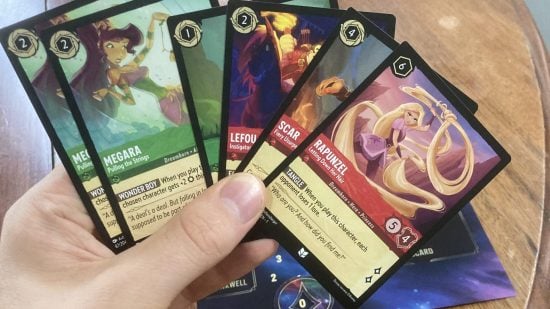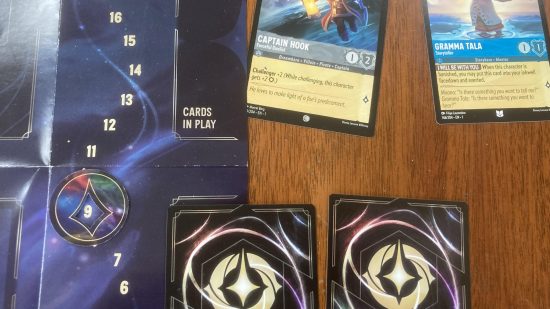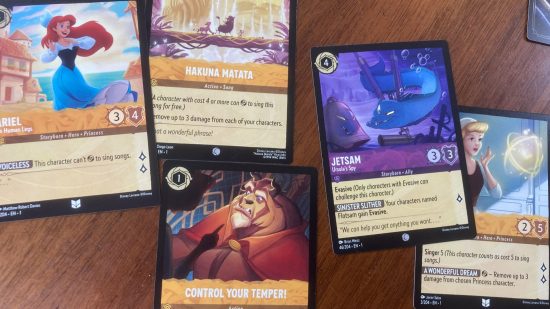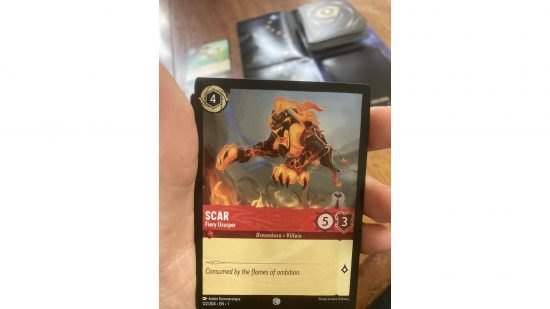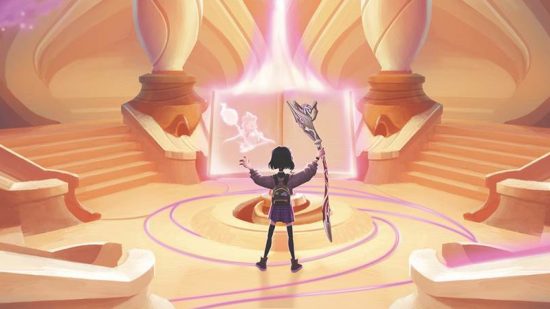When I first found out about Disney Lorcana, I raised an eyebrow at what appeared to be some obvious similarities to my favorite TCG, Magic: The Gathering. I even wrote a couple of pieces comparing Lorcana ink colors to the MTG color pie. But after diving into the game properly and playing around with the three starter decks that come in Disney Lorcana: The First Chapter, I have to admit, it’s won me over.
While there are obvious comparisons to be made to trading card games like Magic (it even uses renamed versions of the untap, upkeep, and draw steps) Disney Lorcana has plenty that’s its own to offer the world of trading card games. There’s lots to like beyond the Disney theming which is, of course, an instant draw for families and Disney-heads everywhere.
But it is theme that has allowed Lorcana to attract so much attention – the game is sold on its Disney flavor. So I should start this review by assuring that here, Ravensburger has not missed the mark. The original artwork will be a hit – just as it is in Disney Villainous (check out our Disney Villainous review) and lots of cards have excellent flavor text from the films.
The card effects are charmingly thematic, too, from a raging Beast breaking items, to the song card Mother Knows Best sending a character back to their hand. It’s funny to see all these instantly familiar characters, songs, and icons mixed and matched in new ways as cards interact, arming Moana with a sword, for instance, or taking Malificent out with a rogue wildebeest stampede.
While Lorcana is perfectly family friendly, I should note that with its combat system, I do find it hard not to picture Flounder from the Little Mermaid and the Duke of Weselton from Frozen locked in mortal combat as they deal damage until one runs out of “willpower”. Yeah, right.
Something that shapes every aspect of how you play Lorcana is the way games are won. You exhaust (tap) your characters to ‘quest’ and gain ‘lore’, and the first to 20 wins. This simple mechanic produces a wealth of decision making because it means with each character there are multiple actions you could pick every turn.
Each character could challenge or quest, or use an ability if they have one. Or – because only exhausted characters can themselves be challenged – you can keep them back, waiting for a safer moment to act.
Challenging is Lorcana’s form of fighting, used to remove opposing characters and disrupt your enemy’s plans. It’s dealt simultaneously, and lingers between turns, so it’s often not worth wasting valuable questing time on an even trade. However, if the opposing creatures are doing better at questing than yours and you’re not winning the race, you can’t just sit back and let your opponent snowball.
Removing key pieces at the right time is crucial, and games can play out very differently, depending on which action (questing or challenging) each player focuses on – though you’ll need to engage in at least a bit of both.
One Disney Lorcana mechanic I really dig is the resource system. Each turn you can select one card from your hand to stick face-down into your inkwell, where it can be tapped to provide an ‘ink’ per turn (which is used to pay for cards).
I love this, because it leaves you constantly considering the cards in your hand and which ones you might want to make do without, something that will endlessly shift with your situation. It’s a novel way of avoiding annoying moments where you have great cards and no resources to play them, or an abundance of resources but no playable cards.
Not every card can be used as ink, but most can. I imagine once the game is out and fans get tinkering with it, people will figure out the optimal number of ink-able cards to include, or that different decks might include more or fewer of these cards, depending on their strategy.
I also quite like the framing device around the game. At first I found the terminology, like ‘glimmers’ and ‘lore’, a bit hokey, but the idea that you’re bringing magical copies of Disney characters to life with ink, is actually pretty neat, and (to me, at least) harkens back to the original hand-drawn animation style of the films.
And in some ways, it’s quite charming. For instance, instead of your characters being unable to act the turn you play them due to ‘summoning sickness’ (a term that seems weirder and weirder the more that I think about it), you instead have to wait a turn for ‘their ink to dry’.
While the mechanics are fairly simple, I had a great time playing Disney Lorcana, and soon felt the familiar click and whir of my TCG-playing brain gearing up, spotting synergies, and figuring out the most efficient ways to use my cards.
One problem I did run into is that, unless you can find a good card draw engine, you sometimes get situations where one or more players are just top decking and playing whatever they draw, leading to uninspiring matches. This may just be a symptom of the starter decks’ low power level, however.
The Disney Lorcana release date is just a month away! It remains to be seen if the TCG can succeed once the initial hype dies down, but with a good game balanced on rock solid IP, it has every reason to.
